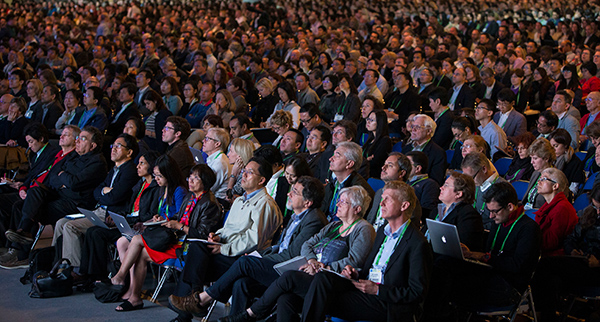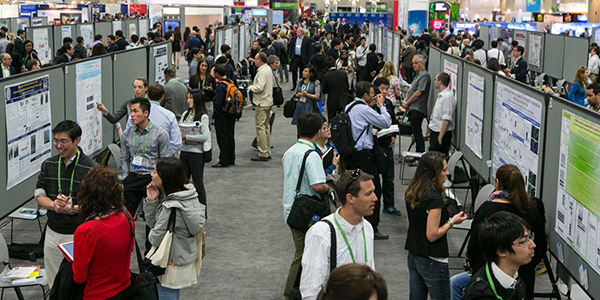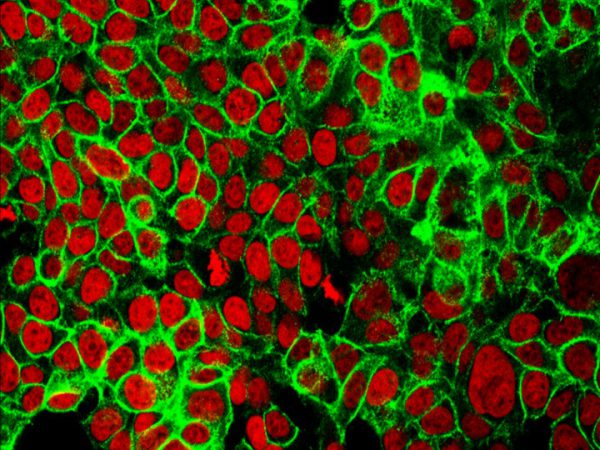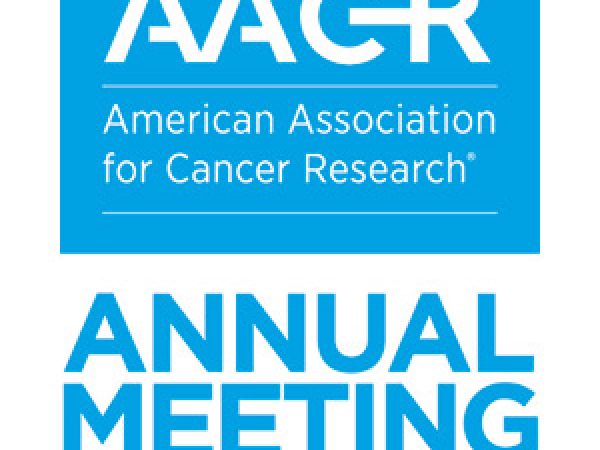Behind the Scenes: Advance Planning and Hard Work Keep the AACR Annual Meeting on Track
Welcome to the first post in our Behind the Scenes series. Over the next few weeks, we’ll provide an inside look at the planning and development of the AACR’s Annual Meeting, a must-attend event for cancer researchers.
When the American Association for Cancer Research’s (AACR) Annual Meeting 2015 begins April 18 in Philadelphia, more than 18,500 attendees will flow seamlessly through five days of workshops, poster sessions, and forums, among other highlights, absorbing the latest, most exciting discoveries in cancer research. The energy at the Pennsylvania Convention Center and two headquarter hotels will be palpable, spurring scientists, clinicians, advocates, and others to fill their itineraries with as much as they can.
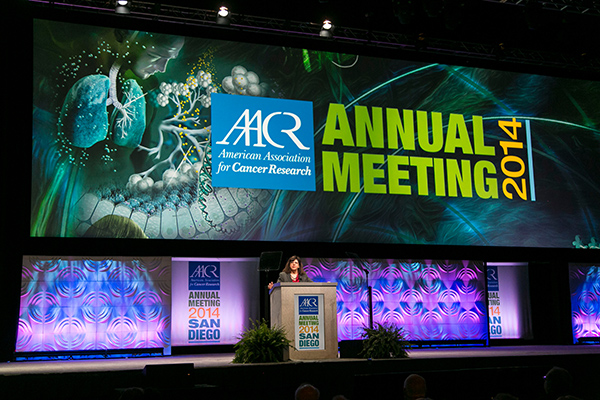
Margaret Foti, PhD, MD (hc), speaks during the opening ceremony of the AACR Annual Meeting 2014 in San Diego.
With so much going on, you may wonder: How does it all come together—and go off without a hitch? Pamela Ballinger, senior director of Meetings and Exhibits at the AACR, and her staff of 14 people handle the meeting’s logistical aspects, ranging from laying out the event space to booking the 8,400-plus hotel rooms for attendees to ordering and managing audiovisual needs. The team also arranges transportation to and from the airport for VIP guests and shuttle buses to and from hotels that are more than a mile from the Pennsylvania Convention Center for all attendees, and orders food and beverages—such as continental breakfasts, lunches, and coffee—for meeting rooms. The department also sells and books booths in the exhibit hall and space in the Spotlight Theater, as well as coordinates the setup of posters in the exhibit hall.
Ballinger says she and her team start planning each Annual Meeting 10 years in advance to secure locations that can accommodate the event.
“You don’t want to wait the year before and say, ‘Oh, I need space and hotel rooms for 19,000 people,’” she says.
Ballinger and her team negotiate contracts with hotels and create a layout for the space two years before the Annual Meeting. They visit the site the summer before to confirm the layout and meet with vendors, including a general contractor—which creates signs, receives and transports shipments of meeting materials such as bags and journals, and physically sets up the event space—a registration company, and security, among others. Throughout the year, the Meetings and Exhibits department also works with the AACR’s Communications, Marketing, Finance, Program Development, and Information Technology departments.
“Basically, everyone who touches the meeting is gradually brought into the planning,” she says.
The team and general contractor start setting up Wednesday morning before the meeting and have only two days to get everything in place.
“We start with a blank canvas on Wednesday morning,” Ballinger says. “By Friday, everything is up.”
During the meeting, she says, her department is on call 18 hours per day to ensure everything runs smoothly as planned.
“We are all over the center and both hotels,” Ballinger says. “We check rooms. We are there for the start of sessions to be sure AV is running correctly. We monitor digital signs. We troubleshoot for all staff and answer all their needs.”
She says attendees should look forward to this year’s scientific program, which includes a wrap-up session with AACR President-elect (2015-2016) Nancy E. Davidson, MD, University of Pittsburgh Cancer Institute; Program Committee Chairperson Lewis C. Cantley, PhD, Sandra and Edward Meyer Cancer Center at Weill Cornell Medical College; AACR President Carlos L. Arteaga, MD, Vanderbilt–Ingram Cancer Center; Cancer Today Editor-in-Chief William G. Nelson, MD, PhD, Johns Hopkins Kimmel Cancer Center; and AACR President-elect (2014-2015) José Baselga, MD, PhD, Memorial Sloan Kettering Cancer Center.
Also, attendees might be pleased by all Philadelphia has to offer. “It is truly a foodie city,” Ballinger says. “We have great restaurants, many within walking distance from the convention center.”
She says her department has its hands in almost every aspect of the Annual Meeting.
“This department thrives on the energy of the meeting and will be available to help our fellow staff and attendees have a positive experience,” Ballinger says. “Everyone is dedicated to making it the best meeting it can possibly be.”

